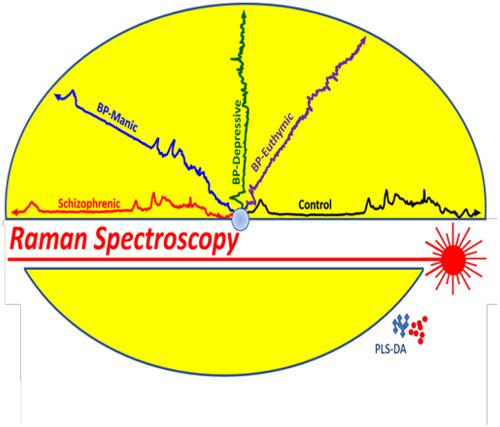当前位置:
X-MOL 学术
›
J. Raman Spectrosc.
›
论文详情
Our official English website, www.x-mol.net, welcomes your
feedback! (Note: you will need to create a separate account there.)
Auxiliary differential diagnosis of schizophrenia and phases of bipolar disorder based on the blood serum Raman spectra
Journal of Raman Spectroscopy ( IF 2.4 ) Pub Date : 2020-08-20 , DOI: 10.1002/jrs.5976 Gulce Ogruc Ildiz 1, 2 , Sevgi Bayari 3 , Umut M. Aksoy 4 , Nese Yorguner 5 , Huseyin Bulut 4 , Sultan S. Yilmaz 6 , Gokhan Halimoglu 1 , Hayrunnisa Nur Kabuk 1 , Gizem Yavuz 1 , Rui Fausto 2, 7
Journal of Raman Spectroscopy ( IF 2.4 ) Pub Date : 2020-08-20 , DOI: 10.1002/jrs.5976 Gulce Ogruc Ildiz 1, 2 , Sevgi Bayari 3 , Umut M. Aksoy 4 , Nese Yorguner 5 , Huseyin Bulut 4 , Sultan S. Yilmaz 6 , Gokhan Halimoglu 1 , Hayrunnisa Nur Kabuk 1 , Gizem Yavuz 1 , Rui Fausto 2, 7
Affiliation

|
Schizophrenia (SZ) and bipolar disorder (BP) are severe psychiatric disorders that are characterized by an extensive spectrum of symptoms and affect approximately 2% of the world population. BP exhibits three well‐distinct phases, which are classified as manic and depressive episodes and euthymic phase. These disorders are of difficult differential clinical diagnosis due to the similarity of their symptoms. Diagnostic approaches for SZ and BP are based on constructed patient interviews and subjective evaluations of clinical symptoms, and there are still no molecular‐based auxiliary diagnostic tools to support the clinical diagnosis. In this study, an analytical model for auxiliary differential diagnosis of SZ and BP, based on the analysis of patients' blood serum Raman spectra, is developed, which is able to account for the different BP phases and can also differentiate SZ and BP patients from healthy individuals. The model is based on a hierarchical sequence of four two‐class PLS‐DA steps where the Raman spectra are the X‐predictor variables. It is concluded that the full 400–3,100 cm−1 Raman spectroscopic range is a sensitive probe for the disorders, thus working as a general spectroscopic biomarker for the illnesses. The proposed methodology is reliable, fast, cheap, essentially minimal‐invasive, and might be implemented easily in the clinical environment.
中文翻译:

基于血清拉曼光谱的精神分裂症和双相情感障碍阶段的辅助鉴别诊断
精神分裂症(SZ)和双相情感障碍(BP)是严重的精神疾病,其特征是症状广泛,并影响约2%的世界人口。BP表现出三个明显不同的阶段,分为躁狂和抑郁发作和正常的阶段。由于它们的症状相似,这些疾病很难进行临床鉴别诊断。SZ和BP的诊断方法基于构建的患者访谈和临床症状的主观评估,并且仍然没有基于分子的辅助诊断工具来支持临床诊断。在这项研究中,基于对患者血清拉曼光谱的分析,建立了用于SZ和BP的辅助鉴别诊断的分析模型,它能够解释不同的BP阶段,还可以区分SZ和BP患者与健康个体。该模型基于四个两级PLS-DA步骤的分层序列,其中拉曼光谱为X预测变量。结论是,整个400–3,100 cm -1拉曼光谱范围是对该疾病的敏感探针,因此可作为疾病的一般光谱生物标记。所提出的方法可靠,快速,便宜,基本上是微创的,并且可能在临床环境中容易实施。
更新日期:2020-08-20
中文翻译:

基于血清拉曼光谱的精神分裂症和双相情感障碍阶段的辅助鉴别诊断
精神分裂症(SZ)和双相情感障碍(BP)是严重的精神疾病,其特征是症状广泛,并影响约2%的世界人口。BP表现出三个明显不同的阶段,分为躁狂和抑郁发作和正常的阶段。由于它们的症状相似,这些疾病很难进行临床鉴别诊断。SZ和BP的诊断方法基于构建的患者访谈和临床症状的主观评估,并且仍然没有基于分子的辅助诊断工具来支持临床诊断。在这项研究中,基于对患者血清拉曼光谱的分析,建立了用于SZ和BP的辅助鉴别诊断的分析模型,它能够解释不同的BP阶段,还可以区分SZ和BP患者与健康个体。该模型基于四个两级PLS-DA步骤的分层序列,其中拉曼光谱为X预测变量。结论是,整个400–3,100 cm -1拉曼光谱范围是对该疾病的敏感探针,因此可作为疾病的一般光谱生物标记。所提出的方法可靠,快速,便宜,基本上是微创的,并且可能在临床环境中容易实施。











































 京公网安备 11010802027423号
京公网安备 11010802027423号